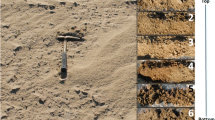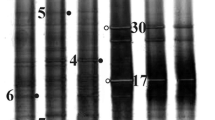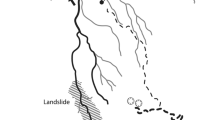Abstract
The endorheic basins of the Northern Chilean Altiplano contain saline lakes and salt flats. Two of the salt flats, Gorbea and Ignorado, have high acidic brines. The causes of the local acidity have been attributed to the occurrence of volcanic native sulfur, the release of sulfuric acid by oxidation, and the low buffering capacity of the rocks in the area. Understanding the microbial community composition and available energy in this pristine ecosystem is relevant in determining the origin of the acidity and in supporting the rationale of conservation policies. Besides, a comparison between similar systems in Australia highlights key microbial components and specific ones associated with geological settings and environmental conditions. Sediment and water samples from the Salar de Gorbea were collected, physicochemical parameters measured and geochemical and molecular biological analyses performed. A low diversity microbial community was observed in brines and sediments dominated by Actinobacteria, Algae, Firmicutes and Proteobacteria. Most of the constituent genera have been reported to be either sulfur oxidizing microorganisms or ones having the potential for sulfur oxidation given available genomic data and information drawn from the literature on cultured relatives. In addition, a link between sulfur oxidation and carbon fixation was observed. In contrast, to acid mine drainage communities, Gorbea microbial diversity is mainly supported by chemolithoheterotrophic, facultative chemolithoautotrophic and oligotrophic sulfur oxidizing populations indicating that microbial activity should also be considered as a causative agent of local acidity.






Similar content being viewed by others
Change history
03 September 2018
In Table 1 of the original article, the unit mg/L was incorrectly published as ng/L in the aluminum, chloride, sulphate and OM columns.
References
Aguilera A (2013) Eukaryotic organisms in extreme acidic environments, the rio tinto case. Life 3:363–374. https://doi.org/10.3390/life3030363
Alpers CN, Rye RO, Nordstrom DK et al (1992) Chemical, crystallographic and stable isotopic properties of alunite and jarosite from acid-Hypersaline Australian lakes. Chem Geol 96:203–226. https://doi.org/10.1016/0009-2541(92)90129-S
Altschul SF, Madden TL, Schaffer AA, Zhang JH, Zhang Z, Miller W, Lipman DJ (1997) Gapped BLAST and PSI-BLAST: a new generation of protein database search programs. Nucleic Acids Res 25(17):3389–3402
Baker BJ, Banfield JF (2003) Microbial communities in acid mine drainage. FEMS Microbiol Ecol 44:139–152. https://doi.org/10.1016/S0168-6496(03)00028-X
Benison KC, Bowen BB (2013) Extreme sulfur-cycling in acid brine lake environments of Western Australia. Chem Geol 351:154–167. https://doi.org/10.1016/j.chemgeo.2013.05.018
Benison KC, Bowen BB, Oboh-Ikuenobe FE et al (2007) Sedimentology of acid saline lakes in southern Western Australia: newly described processes and products of an extreme environment. J Sediment Res 77:366–388. https://doi.org/10.2110/jsr.2007.038
Berg IA (2011) Ecological aspects of the distribution of different autotrophic CO2 fixation pathways. Appl Environ Microbiol 77:1925–1936. https://doi.org/10.1128/AEM.02473-10
Bogdanova TI, Tsaplina IA, Kondrat’eva TF et al (2006) Sulfobacillus thermotolerans sp. nov, a thermotolerant, chemolithotrophic bacterium. Int J Syst Evol Microbiol 56:1039–1042. https://doi.org/10.1099/ijs.0.64106-0
Bond PL, Druschel GK, Banfield JF (2000) Comparison of acid mine drainage microbial communities in physically and geochemically distinct ecosystems. Appl Environ Microbiol 66:4962–4971. https://doi.org/10.1128/AEM.66.11.4962-4971.2000.Updated
Cañamás TP, Viñas I, Abadias M et al (2009) Acid tolerance response induced in the biocontrol agent Pantoea agglomerans CPA-2 and effect on its survival ability in acidic environments. Microbiol Res 164:438–450. https://doi.org/10.1016/j.micres.2007.02.007
Casamayor EO, Muyzer G, Pedrós-Alió C (2001) Composition and temporal dynamics of planktonic archaeal assemblages from anaerobic sulfurous environments studied by 16S rDNA denaturing gradient gel electrophoresis and sequencing. Aquat Microb Ecol 25:237–246. https://doi.org/10.3354/ame025237
Chen Q, Yao L, Wang CH et al (2013) Isolation and characterization of acetochlordegrading strain Sphingomonas sp. DC-6 and preliminary studies on its metabolic pathway. J Agric Sci Technol 15:67–74
Chen L, Huang L, Méndez-García C et al (2016) Microbial communities, processes and functions in acid mine drainage ecosystems. Curr Opin Biotechnol 38:150–158. https://doi.org/10.1016/j.copbio.2016.01.013
Choi BR, Pham VH, Park SJ, Kim SJ, Roh DH, Rhee SK (2009) Characterization of facultative sulfur-oxidizing marinobacter sp. BR13 isolated from marine sediment of Yellow Sea, Korea. J Korean Soc Appl Biol Chem 52:309–314
Chong G, Cortez P, Escudero L et al (2015) Geomicrobiology in an acid hypersaline system in Northern Chile. In: XIV Congreso Geológico Chileno. La Serena, Chile, 4–8 October 2015
Cornejo P (1987) Hydrothermal alteration zones and sulphur deposits in Upper Cenozoic volcanoes of Salar de Gorbea, Andes of northern Chile. In: Pacific Rim congress, 87. Proceeding of the international congress
Cortez P (2014) Caracterización geológica de los salares gorbea e ignorado y su asociación con su microbiota. Universidad Católica del Norte, Antofagasta
Dahl C (2017) Sulfur metabolism in phototrophic bacteria. In: Hallenbeck PC (ed) Modern topics in the phototrophic prokaryotes. Springer International Publishing, Cham, pp 27–66
Davis-Belmar CS, Pinto E, Demergasso C, Rautenbach G (2013) Proteo and Actinobacteria diversity at a sulfide, salt and acid -rich lake in the north of Chile. Adv Mater Res 825:37–41. https://doi.org/10.4028/www.scientific.net/AMR.825.37
Demergasso C, Casamayor EO, Chong G et al (2004) Distribution of prokaryotic genetic diversity in athalassohaline lakes of the Atacama Desert, Northern Chile. FEMS Microbiol Ecol 48:57–69. https://doi.org/10.1016/j.femsec.2003.12.013
Demergasso CS, Guillermo CD, Lorena EG et al (2007) Microbial precipitation of arsenic sulfides in andean salt flats. Geomicrobiol J 24:111–123. https://doi.org/10.1080/01490450701266605
Demergasso C, Escudero L, Casamayor EO et al (2008) Novelty and spatio-temporal heterogeneity in the bacterial diversity of hypersaline Lake Tebenquiche (Salar de Atacama). Extremophiles 12:491–504. https://doi.org/10.1007/s00792-008-0153-y
Demergasso C, Galleguillos F, Soto P, Serón M, Iturriaga V (2010) Microbial succession during a heap bioleaching cycle of low grade copper sulfides: does this knowledge mean a real input for industrial process design and control? Hydrometallurgy 104(3–4):382–390
Escudero LV, Bijman J, Chong G et al (2013) Geochemistry and microbiology in an acidic, high altitude (4,000 m) salt flat—high andes, Northern Chile. Adv Mater Res 825:28–32. https://doi.org/10.4028/www.scientific.net/AMR.825.28
Escudero L, Bijman J, Mariela GM et al (2015) Organotrophic and mixotrofic sulfur oxidation in an acidic salt flat in Northern Chile. Adv Mater Res 1130:63–66. https://doi.org/10.4028/www.scientific.net/AMR.1130.63
España JS, Pamo EL, Santofimia E et al (2005) Acid mine drainage in the Iberian Pyrite Belt (Odiel river watershed, Huelva, SW Spain): geochemistry, mineralogy and environmental implications. Appl Geochem 20:1320–1356. https://doi.org/10.1016/j.apgeochem.2005.01.011
Esparza M, Crdenas JP, Bowien B et al (2010) Genes and pathways for CO2fixation in the obligate, chemolithoautotrophic acidophile, Acidithiobacillus ferrooxidans, Carbon fixation in A. ferrooxidans. BMC Microbiol. https://doi.org/10.1186/1471-2180-10-229
Falkinham JO (2009) Surrounded by mycobacteria: nontuberculous mycobacteria in the human environment. J Appl Microbiol 107:356–367. https://doi.org/10.1111/j.1365-2672.2009.04161.x
Frerichs J, Oppermann BI, Gwosdz S et al (2013) Microbial community changes at a terrestrial volcanic CO2 vent induced by soil acidification and anaerobic microhabitats within the soil column. FEMS Microbiol Ecol 84:60–74. https://doi.org/10.1111/1574-6941.12040
Fuggi A, Pinto G, Pollio A et al (1988) Effects of NaCI, Na2 SO4, H2SO4, and glucose on growth, photosynthesis, and respiration in the acidophilic alga Dunaliella acidophila (Volvocales, Chlorophyta). Phycol 27:334–339. https://doi.org/10.2216/i0031-8884-27-3-334.1
González-Toril E, Santofimia E, Blanco Y et al (2015) Pyrosequencing-based assessment of the microbial community structure of Pastoruri glacier area (Huascarán National Park, Perú), a natural extreme acidic environment. Microb Ecol 70:936–947. https://doi.org/10.1007/s00248-015-0634-3
Gregersen LH, Bryant DA, Frigaard N-U (2011) Mechanisms and evolution of oxidative sufur metabolism in green sulfur bacteria. Front Microbiol 2:116. https://doi.org/10.3389/fmicb.2011.00116
Guo X, You XY, Liu LJ, et al (2009) Alicyclobacillus aeris sp. nov., a novel ferrous-and sulfur-oxidizing bacterium isolated from a copper mine. Int J Syst Evol Microbiol 59:2415–2420. doi: https://doi.org/10.1099/ijs.0.008870-0. http://www.genome.jp/kegg/ KEGG: Kyoto encyclopedia of genes and genomes. http://www.genome.jp/kegg/
Imhoff J (2016) New dimensions in microbial ecology—functional genes in studies to unravel the biodiversity and role of functional microbial groups in the environment. Microorganisms 4:19. https://doi.org/10.3390/microorganisms4020019
Ivanova AE, Kizilova AK, Kanat’eva AY et al (2013) A hydrocarbonoxidizing acidophilic thermotolerant bacterial association from sulfur blocks. Microbiol 82:482–489. https://doi.org/10.1134/S0026261713040048
Jacob JH, Irshaid FI (2013) A new strain of Shewanella putrefaciens isolated from the Dead Sea of Jordan. Malaysian Appl Biol 42:13–19
Jiménez DJ, Andreote FD, Chaves D et al (2012) Structural and functional insights from the metagenome of an acidic hot spring microbial planktonic community in the Colombian Andes. PLoS ONE 7:1–15. https://doi.org/10.1371/journal.pone.0052069
Johnson SS, Chevrette MG, Ehlmann BL, Benison KC (2015) Insights from the metagenome of an acid salt lake: the role of biology in an extreme depositional environment. PLoS ONE 10:1–19. https://doi.org/10.1371/journal.pone.0122869
Jung J, Jang K, Sihn E et al (2005) Characteristics of sulfur oxidation by a newly isolated Burkholderia spp. J Microbiol Biotechnol 15:716–721
Kaye JZ, Sylvan JB, Edwards KJ et al (2011) Halomonas and marinobacter ecotypes from hydrothermal vent, subseafloor and deep-sea environments. FEMS Microbiol Ecol 75:123–133. https://doi.org/10.1111/j.1574-6941.2010.00984.x
Kim D, Baik KS, Kim MS et al (2007) Shewanella haliotis sp. nov., isolated from the gut microflora of abalone, Haliotis discus hannai. Int J Syst Evol Microbiol 57:2926–2931. https://doi.org/10.1099/ijs.0.65257-0
Kopecky J, Kyselkova M, Omelka M et al (2011) Actinobacterial community dominated by a distinct clade in acidic soil of a waterlogged deciduous forest. FEMS Microbiol Ecol 78:386–394. https://doi.org/10.1111/j.1574-6941.2011.01173.x
Kusumi A, Li XS, Katayama Y (2011) Mycobacteria isolated from Angkor monument sandstones grow chemolithoautotrophically by oxidizing elemental sulfur. Front Microbiol 2:1–7. https://doi.org/10.3389/fmicb.2011.00104
Langille MGI, Zaneveld J, Caporaso JG et al (2013) Predictive functional profiling of microbial communities using 16S rRNA marker gene sequences. Nat Biotechnol 31:814–821. https://doi.org/10.1038/nbt.2676
Lara J, González LE, Ferrero M et al (2012) Enrichment of arsenic transforming and resistant heterotrophic bacteria from sediments of two salt lakes in Northern Chile. Extremophiles 16:523–538. https://doi.org/10.1007/s00792-012-0452-1
Lauber CL, Hamady M, Knight R, Fierer N (2009) Pyrosequencing-based assessment of soil pH as a predictor of soil bacterial community structure at the continental scale. Appl Environ Microbiol 75:5111–5120. https://doi.org/10.1128/AEM.00335-09
Lee CS, Kim KK, Aslam Z, Lee ST (2007) Rhodanobacter thiooxydans sp. nov., isolated from a biofilm on sulfur particles used in an autotrophic denitrification process. Int J Syst Evol Microbiol 57:1775–1779. https://doi.org/10.1099/ijs.0.65086-0
Lee JH, Park DO, Park SW et al (2009) Expression and regulation of ribulose 1,5-bisphosphate carboxylase/oxygenase genes in Mycobacterium sp. strain JC1 DSM 3803. J Microbiol 47:297–307. https://doi.org/10.1007/s12275-008-0210-3
Leu JY, McGovern-Traa CP, Porter AJR, Hamilton WA (1999) The same species of sulphate-reducing Desulfomicrobium occur in different oil field environments in the North Sea. Lett Appl Microbiol 29:246–252
Levicán G, Ugalde JA, Ehrenfeld N et al (2008) Comparative genomic analysis of carbon and nitrogen assimilation mechanisms in three indigenous bioleaching bacteria: predictions and validations. BMC Genomic 9:1–19. https://doi.org/10.1186/1471-2164-9-581
Li X, Kappler U, Jiang G, Bond PL (2017) The ecology of acidophilic microorganisms in the corroding concrete sewer environment. Front Microbiol 8:1–16. https://doi.org/10.3389/fmicb.2017.00683
Long DT, Fegan NE, Lyons WB et al (1992) Geochemistry of acid brines: Lake Tyrrell, Victoria, Australia. Chem Geol 96:33–52. https://doi.org/10.1016/0009-2541(92)90120-T
Lozupone CA, Knight R (2007) Global patterns in bacterial diversity. Proc Natl Acad Sci USA 104:11436–11440. https://doi.org/10.1073/pnas.0611525104
Ma Y, Galinski EA, Grant WD et al (2010) Halophiles 2010: life in saline environments. Appl Environ Microbiol 76:6971–6981. https://doi.org/10.1128/AEM.01868-10
Macumber PG (1992) Hydrological processes in the Tyrrell Basin, southeastern Australia. Chem Geol 96:1–18. https://doi.org/10.1016/0009-2541(92)90118-O
Mann AW (1983) Hydrogeochemistry and weathering on the Yilgarn Block, Western Australia-ferrolysis and heavy metals in continental brines. Geochim Cosmochim Acta 47:181–190. https://doi.org/10.1016/0016-7037(83)90131-X
Marín S, Acosta M, Galleguillos P et al (2017) Is the growth of microorganisms limited by carbon availability during chalcopyrite bioleaching? Hydrometallurgy 168:13–20. https://doi.org/10.1016/j.hydromet.2016.10.003
Mayeux B, Fardeau ML, Bartoli-Joseph M, Casalot L, Vinsot A et al (2013) Desulfosporosinus burensis sp. nov., a spore-forming, mesophilic, sulfate-reducing bacterium isolated from a deep clay environment. Int J Syst Evol Microbiol 63:593–598
McArthur JM, Turner JV, Lyons WB et al (1991) Hydrochemistry on the yilgarn block, western Australia: ferrolysis and mineralisation in acidic brines. Geochim Cosmochim Acta 55:1273–1288. https://doi.org/10.1016/0016-7037(91)90306-P
Meyer B, Imhoff JF, Kuever J (2007) Molecular analysis of the distribution and phylogeny of the soxB gene among sulfur-oxidizing bacteria-evolution of the Sox sulfur oxidation enzyme system. Environ Microbiol 9:2957–2977
Mokracka J, Koczura R, PawŁowski K, Kaznowski A (2011) Resistance patterns and integron cassette arrays of enterobacter cloacae complex strains of human origin. J Med Microbiol 60:737–743. https://doi.org/10.1099/jmm.0.027979-0
Montes MJ, Bozal N, Mercadé E (2008) Marinobacter guineae sp. nov., a novel moderately halophilic bacterium from an Antarctic environment. Int J Syst Evol Microbiol 58:1346–1349. https://doi.org/10.1099/ijs.0.65298-0
Mormile MR, Hong B-Y, Benison KC (2009) Molecular analysis of the microbial communities of Mars analog lakes in Western Australia. Astrobiology 9:919–930. https://doi.org/10.1089/ast.2008.0293
Nealson KH (1996) Growth of the facultative anaerobe Shewanella putrefaciens by elemental sulfur reduction. Appl Environ Microbiol 62:2100
Newman DK, Kennedy EK, Coates JD, Ahmann D, Ellis DJ, Lovley DR, Morel FM (1997) Dissimilatory arsenate and sulfate reduction in Desulfotomaculum auripigmentum sp. nov. Arch Microbiol 168(5):380–388
Norris PR, Marsh RM, Lindstrom EB (1986) Growth of mesophilic and thermophilic acidophilic bacteria on sulfur and tetrathionate. Biotechnol Appl Biochem 8:318–329
Novis PM, Harding JS (2002) Extreme acidophiles: freshwater algae associated with acid mine drainage. In: Seckbach J (ed) Algae and cyanobacteria in extreme environments. Springer, Dordrecht, pp 443–463
Oren A (2006) Life at high salt concentrations. In: Dworkin M, Falkow S, Rosenberg E, Schleifer K-H, Stackebrandt E (eds) The prokaryotes. A handbook on the biology of bacteria: ecophysiology and biochemistry. Springer, New York, pp 263–282
Oren A (2011) Thermodynamic limits to microbial life at high salt concentrations. Environ Microbiol 13:1908–1923. https://doi.org/10.1111/j.1462-2920.2010.02365
Pascual J, Lucena T, Ruvira MA et al (2012) Pseudomonas litoralis sp. nov., isolated from mediterranean seawater. Int J Syst Evol Microbiol 62:438–444. https://doi.org/10.1099/ijs.0.029447-0
Quatrini R, Escudero LV, Moya-Beltrán A et al (2017) Draft genome sequence of Acidithiobacillus thiooxidans CLST isolated from the acidic hypersaline Gorbea salt flat in northern Chile. Stand Genomic Sci 12:84. https://doi.org/10.1186/s40793-017-0305-8
Rahman SS, Siddique R, Tabassum N (2017) Isolation and identification of halotolerant soil bacteria from coastal Patenga area. BMC Res Notes 10:531. https://doi.org/10.1186/s13104-017-2855-7
Risacher F, Alonso H, Salazar C (2002) Hydrochemistry of two adjacent acid saline lakes in the Andes of northern Chile. Chem Geol 187:39–57. https://doi.org/10.1016/S0009-2541(02)00021-9
Sallam A, Steinbüchel A (2009) Clostridium sulfidigenes sp. nov., a mesophilic, proteolytic, thiosulfate- and sulfur-reducing bacterium isolated from pond sediment. Int J Syst Evol Microbiol 59:1661–1665
Shelobolina E, Konishi H, Xu H et al (2012) Isolation of phyllosilicate-iron redox cycling microorganisms from an illite-smectite rich hydromorphic soil. Front Microbiol 3:1–10. https://doi.org/10.3389/fmicb.2012.00134
Shimizu R, Dempo Y, Nakayama Y et al (2015) New insight into the role of the calvin cycle: reutilization of CO2 emitted through sugar degradation. Sci Rep. https://doi.org/10.1038/srep11617
Stahl DA, Urbance JW (1990) The division between fast and slowgrowing species corresponds to natural relationships among the mycobacteria. J Bacteriol 172:116–124
Takeda M, Kamagata Y, Ghiorse WC et al (2002) Caldimonas manganoxidans gen. nov., sp. nov., a poly(3-hydroxybutyrate)-degrading, manganese-oxidizing thermophile. Int J Syst Evol Microbiol 52:895–900. https://doi.org/10.1099/ijs.0.02027-0
Thollot P, Mangold N, Ansan V et al (2012) Most Mars minerals in a nutshell: various alteration phases formed in a single environment in Noctis Labyrinthus. J Geophys Res E Planets 117:1–28. https://doi.org/10.1029/2011JE004028
Tosca NJ, McLennan SM, Lamb MP, Grotzinger JP (2011) Physicochemical properties of concentrated Martian surface waters. J Geophys Res 116:E05004. https://doi.org/10.1029/2010JE003700
Uyttebroek M, Vermeir S, Wattiau P, Ryngaert A, Springael D (2007) Characterization of cultures enriched from acidic polycyclic aromatic hydrocarbon_contaminated soil for growth on pyrene at low pH. Appl Environ Microbiol 73:3159–3164
Ventosa A, Nieto JJ, Oren A (1998) Biology of moderately halophilic aerobic bacteria. Microbiol Mol Biol Rev 62:504–544
Ventosa A, Fernández AB, León MJ et al (2014) The Santa Pola saltern as a model for studying the microbiota of hypersaline environments. Extremophiles 18:811–824. https://doi.org/10.1007/s00792-014-0681-6
Walker JJ, Spear JR, Pace NR (2005) Geobiology of a microbiol endolithic community in the Yellowstone geothermal environment. Nature 434:1011–1014. https://doi.org/10.1038/nature03447
Watling HR, Perrot FA, Shiers DW (2008) Comparison of selected characteristics of Sulfobacillus species and review of their occurrence in acidic and bioleaching environments. Hydrometallurgy 93(1–2):57–65
Weon HY, Kim BY, Hong SB et al (2007) Rhodanobacter ginsengisoli sp. nov. and Rhodanobacter terrae sp. nov., isolated from soil cultivated with Korean ginseng. Int J Syst Evol Microbiol 57:2810–2813. https://doi.org/10.1099/ijs.0.65018-0
Widdel F, Bak F (1992) Gram negative mesophilic sulfate reducing bacteria. In: Balows A, Truper HG, Dworkin M, Harder W, Schleifer KH (eds) The prokaryotes. A handbook on the biology of bacteria: ecophysiology, isolation, identification, and applications. Springer, New York, pp 3352–3378
Zhong ZP, Liu Y, Hou TT et al (2015) Pseudomonas salina sp. nov., isolated from a salt lake. Int J Syst Evol Microbiol 65:2846–2851. https://doi.org/10.1099/ijs.0.000341
Zviagintsev DG, Zenova GM, Doroshenko EA et al (2007) Actinomycete growth in conditions of low moisture. Izv Akad Nauk Ser Biol 34:296–302. https://doi.org/10.1134/S1062359007030053
Acknowledgements
Fondecyt Project 1100795, BHP Minerals Americas Project 32002137.
Author information
Authors and Affiliations
Corresponding author
Ethics declarations
Conflict of interest
The authors declare that they have no conflict of interest.
Ethical statement
The authors have not carried out any studies involving human participants or animals.
Electronic supplementary material
Below is the link to the electronic supplementary material.
Rights and permissions
About this article
Cite this article
Escudero, L., Oetiker, N., Gallardo, K. et al. A thiotrophic microbial community in an acidic brine lake in Northern Chile. Antonie van Leeuwenhoek 111, 1403–1419 (2018). https://doi.org/10.1007/s10482-018-1087-8
Received:
Accepted:
Published:
Issue Date:
DOI: https://doi.org/10.1007/s10482-018-1087-8




